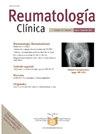Mean corpuscular volume and red cell distribution width as predictors of methotrexate response in RA patients
IF 1.3
Q4 RHEUMATOLOGY
引用次数: 0
Abstract
Objective
To correlate ΔRDW and ΔVCM (baseline and week 12) with the number of patients achieving remission or low disease activity by CDAI at week 24 after initiating MTX.
Materials and methods
Retro-prospective, analytical, and observational study in consecutive adult patients diagnosed with RA (ACR/EULAR 2010). Demographic data, clinical characteristics, personal history, initiated treatments, and VCM (fL) and RDW (%) at weeks 0, 4, 12, and 24 were evaluated. Safety data was recorded. Statistical analysis: descriptive analysis, Chi2 test or Fisher's exact test; Student's T-test or Mann–Whitney; and ANOVA or Kruskal–Wallis. Lineal and/or multiple logistic regression.
Results
139 patients were included, of whom 109 completed the study requirements. 83.5% were women, median age (m) 50 years (IQR 39–60), with a median disease duration of 12 months (IQR 0–78). In the per-protocol analysis of 109 patients, the m ΔRDW between baseline and week 12 was 0.8 (IQR 0–2.4), and the m ΔVCM was 2.0 (IQR 0.1–4.4). No correlation was found between ΔRDW and CDAI at week 24 (Rho = −0.08; p = 0.416), but a statistically significant correlation was found between ΔVCM and CDAI at week 24 (Rho = −0.190; p = 0.048).
Results were analyzed by intention to treat for 139 patients. Between baseline and week 12, a m ΔRDW of 0.8 (IQR 0–2.4) and a m ΔVCM of 2.2 (IQR 0.2–4.5) were recorded. No correlation was found between ΔRDW and CDAI at week 24 (Rho = −0.073; p = 0.433), but a statistically significant correlation was found between ΔVCM and CDAI at week 24 (Rho = −0.217; p = 0.018). 64.2%, 39.4%, and 15.6% of patients achieved CDAI 50/70/85 responses at week 12, respectively, with no significant changes at week 24. Univariate and multivariate analysis identified that the only factor significantly associated with achieving CDAI 50 at week 24 was achieving such a response at week 12 (p = 0.001).
Safety evaluation showed that 68 patients (48.9%) experienced adverse events, with 20 events (14.4%) related to MTX. Only 5 (3.6%) were considered serious adverse events, all of them unrelated to treatment.
Conclusions
This study revealed that an increase in red cell distribution width (RDW) and mean corpuscular volume (VCM) was associated with the initiation of MTX treatment. However, only a significant correlation was found between the change in VCM and RA activity measured by CDAI at week 24. Although ΔRDW did not show a significant association with RA activity, ΔVCM negatively correlated with CDAI at week 24. Additionally, a significant percentage of patients achieved a positive response at week 12, but there were no significant changes at week 24. Safety analysis showed that some patients experienced adverse events, with a small proportion considered serious adverse events not related to treatment. Overall, these findings suggest the importance of monitoring changes in VCM and considering its relationship with RA activity during MTX treatment.
平均红细胞体积和红细胞分布宽度作为RA患者甲氨蝶呤反应的预测因子
目的:将ΔRDW和ΔVCM(基线和第12周)与开始MTX治疗后第24周通过CDAI达到缓解或低疾病活动度的患者人数联系起来。材料和方法对诊断为RA的连续成年患者进行回顾性、前瞻性、分析性和观察性研究(ACR/EULAR 2010)。评估第0、4、12和24周的人口统计数据、临床特征、个人病史、开始治疗以及VCM (fL)和RDW(%)。记录安全数据。统计分析:描述性分析、Chi2检验或Fisher精确检验;学生t检验或Mann-Whitney检验;和方差分析或Kruskal-Wallis。线性和/或多重逻辑回归。结果139例患者纳入研究,其中109例完成了研究要求。83.5%为女性,中位年龄50岁(IQR 39-60),中位病程12个月(IQR 0-78)。在109例患者的按方案分析中,基线至第12周的m ΔRDW为0.8 (IQR 0-2.4), m ΔVCM为2.0 (IQR 0.1-4.4)。ΔRDW与第24周CDAI无相关性(Rho = - 0.08;p = 0.416),但在第24周ΔVCM与CDAI之间发现有统计学意义的相关性(Rho = - 0.190;p = 0.048)。结果对139例患者进行意向治疗分析。在基线和第12周之间,记录m ΔRDW为0.8 (IQR 0-2.4)和m ΔVCM为2.2 (IQR 0.2-4.5)。ΔRDW与第24周CDAI无相关性(Rho = - 0.073;p = 0.433),但在第24周ΔVCM与CDAI之间发现有统计学意义的相关性(Rho = - 0.217;p = 0.018)。64.2%、39.4%和15.6%的患者在第12周分别达到了CDAI 50/70/85应答,在第24周无显著变化。单因素和多因素分析发现,与第24周达到CDAI 50显著相关的唯一因素是在第12周达到这样的反应(p = 0.001)。安全性评价显示,68例(48.9%)患者出现不良事件,其中20例(14.4%)与MTX相关。只有5例(3.6%)被认为是严重不良事件,均与治疗无关。结论本研究表明,红细胞分布宽度(RDW)和平均红细胞体积(VCM)的增加与MTX治疗的开始有关。然而,在第24周时,仅发现VCM变化与CDAI测量的RA活性之间存在显著相关性。虽然ΔRDW没有显示出与RA活动的显著关联,但ΔVCM与第24周的CDAI呈负相关。此外,在第12周有很大比例的患者达到了阳性反应,但在第24周没有明显的变化。安全性分析显示,一些患者出现了不良事件,一小部分患者被认为是与治疗无关的严重不良事件。总的来说,这些发现表明在MTX治疗期间监测VCM变化并考虑其与RA活动的关系的重要性。
本文章由计算机程序翻译,如有差异,请以英文原文为准。
求助全文
约1分钟内获得全文
求助全文
来源期刊

Reumatologia Clinica
RHEUMATOLOGY-
CiteScore
2.40
自引率
6.70%
发文量
105
审稿时长
54 days
期刊介绍:
Una gran revista para cubrir eficazmente las necesidades de conocimientos en una patología de etiología, expresividad clínica y tratamiento tan amplios. Además es La Publicación Oficial de la Sociedad Española de Reumatología y del Colegio Mexicano de Reumatología y está incluida en los más prestigiosos índices de referencia en medicina.
 求助内容:
求助内容: 应助结果提醒方式:
应助结果提醒方式:


